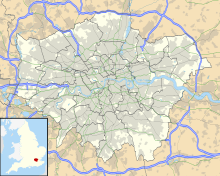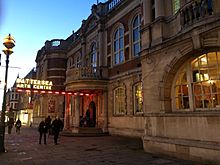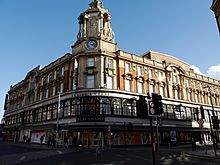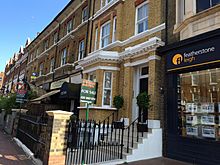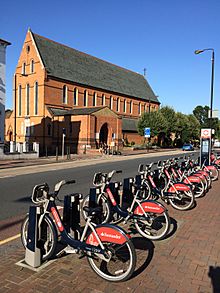Lavender Hill facts for kids

View of restaurants on the central section of Lavender Hill, looking east
|
|
| Former name(s) | Lavender Place (eastern end) |
|---|---|
| Part of | A3036 |
| Maintained by | Wandsworth Borough Council |
| Length | 0.8 mi (1.3 km) |
| Location | London, United Kingdom |
| Postal code | SW11 |
| Nearest rail station | Clapham Junction Railway Station |
| Coordinates | 51°27′54″N 0°09′29″W / 51.46508°N 0.15802°W |
| West end | Clapham Junction |
| East end | Wandsworth Road |
| Other | |
| Known for |
|
Lavender Hill is a hill, and a shopping and residential street, near Clapham Junction in Battersea, south London. Lavender Hill forms the section of the A3036 as it rises eastwards out of the Falconbrook valley at Clapham Junction, and retains that name for approximately 1.3 km to the corner of Queenstown Road in Battersea, beyond which it is called Wandsworth Road towards Vauxhall.
Contents
History
Origin of the name
The earliest known reference to the name 'Lavender Hill' is in 1774 when a Mr Porter, advertising a reward for the return of his lost pony, described it as having strayed or been stolen from 'a Field on Lavender-Hill', suggesting that the name was already widely known. The road formed part of the Southwark to Kingston Turnpike from 1717.
The name refers to the commercial cultivation of lavender on the gentle north-facing slopes of this part of the Thames estuary – helped by well-drained soil, fresh air and several natural springs.
The first building to reflect the name was Lavender Hall on the south side of the road in 1790. The road itself, which ran just below the crest of the hill, was not widely referred to as Lavender Hill until the later 1800s. Several smaller streets developed in the Victoria era, including Lavender Gardens, Lavender Walk (an ancient farm lane) and Lavender Sweep, also reflect the area's historic lavender industry.
Victorian era
The opening of Clapham Junction railway station in 1863 led to rapid residential and commercial development along the street, with construction of a large number of houses as well as many major civic and commercial buildings. By 1885 it was such a busy commercial district that Arding & Hobbs, the largest department store south of the River Thames, was built.
The imposing Church of the Ascension, designed by James Brooks, was built in 1883 to cater to the growing population of the neighbouring Shaftesbury Estate. A Welsh Methodist chapel was built on Beauchamp Road, reflecting what was once a significant Welsh population.
Battersea Central Library was opened in March 1890, following an architectural competition that was won by Edward William Mountford (who also designed the Old Bailey) with a mildly Flemish Renaissance design that was described as "inexpensively devised and designed to not needlessly clash with the adjoining houses which are of the speculating builders’ type of work". It quickly proved popular and saw several subsequent extensions, notably with the addition in 1924 of a reference library on Altenburg Gardens (in a part of the original plot that had originally been intended for a museum) that was designed by Henry Hyams.
Battersea Town Hall was opened in 1893, as the administrative headquarters of the Metropolitan Borough of Battersea, and the large Grade II* listed building is one of Lavender Hill's most prominent features. When the Borough was abolished in 1965, the Town Hall became redundant. After being threatened with demolition for some years, plans to build a new library and swimming pool on the site were finally rejected following a campaign by residents to save the building, and it was then converted into a community arts centre in 1974. The Battersea Arts Centre is now a major arts venue.
The Shakespeare Theatre was built in 1896, next to the Town Hall. It was severely damaged in the Second World War, before being demolished in 1957 and replaced by an office building called Shakespeare House.
A large Central Post Office, designed by Jasper Wager, was built in 1898, and extended with a sorting office designed by John Rutherford in around 1913 (although the original buildings were replaced by a modern structure designed by an unknown architect at the Ministry of Works in 1961).
Contemporary
Retail
Lavender Hill is now principally a shopping and restaurant street along much of its length, with around 200 retail units in total. The Lavender Hill Traders' Association runs the annual Lavender Festival, to raise the profile of the street as a shopping and entertainment destination.
The western end of the street has the highest footfall, due to large commuter flows towards Clapham Junction station. Its architecture is dominated by the landmark Arding & Hobbs building (the greater part of which is still a department store, now Debenhams), a number of restaurants and cafes (including a branch of Pizza Express with decoration loosely themed on The Lavender Hill Mob). There is a large Asda supermarket with an underground car park, and a branch of Whole Foods Market. This section also includes the Battersea central Post Office and telephone exchange, and the Grade II listed Battersea Reference Library.
The flatter central section of the road, at the top of the hill, includes approximately 15 estate agents (including Courtenay, Winkworth and Foxtons), as well as Lavender Hill police station (the main police station for the Battersea area) and the Battersea Arts Centre. There is a concentration of restaurants and bars along the central section.
The eastern end of the street is anchored by smaller branches of Sainsbury's and Tesco at the crossroads with Queenstown Road. It includes a wide variety of restaurants and bars, helped by wide pavements that provide outdoor seating. There are also clusters of shops from sectors including cycling, music equipment, interior design, decorators merchants, and contemporary furniture. This section of the road is dominated by independent businesses with relatively few national operators (with the exception of a few cafes such as Caffè Nero).
In 2011, Wandsworth Borough Council completed the first phase of the Clapham Junction Exemplar project, which extensively de-cluttered and upgraded the streetscape of the western part of Lavender Hill to make it a more attractive and welcoming retail environment. This included widening of pavements, new street lighting, safer pedestrian crossings, and extensive use of granite paving.
Business
Although primarily residential, Lavender Hill includes significant office space, notably at the Battersea Business Centre, which provides workspace for around 140 businesses in a converted Victorian paper mill at 99-109 Lavender Hill.
The area around Lavender Hill included a small proportion of industrial land use (including the area now occupied by the Asda supermarket which was originally a rail yard). Some small sites continued into the early 2000s (with manufacturers such as Rotoplas precision engineering on Stormont Road); however, almost all industrial land has been converted to residential development as the area has gentrified.
Residential
Lavender Hill is in the centre of a high density middle class residential neighbourhood, of predominantly Victorian architecture, including the large Shaftesbury Park Estate.
There is a Travelodge hotel on Falcon Lane close to the western end of Lavender Hill, and a new Premier Inn has been constructed near the eastern end of Lavender Hill (in a former Temperance Hall at the junction with Wandsworth Road).
Transport
Lavender Hill has a Public transport accessibility level of 5 along most of its length, rising to the highest level of 6b at its westen end, indicating a high density of public transport.
Transport at the western end of Lavender Hill is dominated by Clapham Junction railway station, one of the busiest in Europe. The eastern end is an approximately ten-minute walk from several smaller stations, notably Wandsworth Road railway station, Clapham Common Underground station and Queenstown Road railway station.
In the 1890s Lavender Hill was developed as a major tram route, with tram route 26 running along Lavender Hill on the way from Kew Bridge to London Bridge, and route 28 running from Harrow Road to Victoria. The tram lines were removed in the early 1950s and replaced by several bus services (currently including the 77, 87 and 156 buses). These services still follow the same route between Wandsworth and Vauxhall, and Lavender Hill has an eastbound bus lane along much of its length.
There are three Santander Cycles public cycle hire docking stations on or close to Lavender Hill (on Dorothy Road at the western end, on Lavender Hill itself close to the junction with Sugden Road, and on Ashley Crescent at the eastern end).
On 10 August 2017, a 77 bus left the road and collided with a shopfront on the street, injuring 10 people. The driver was described as having lost consciousness at the time of the crash.


